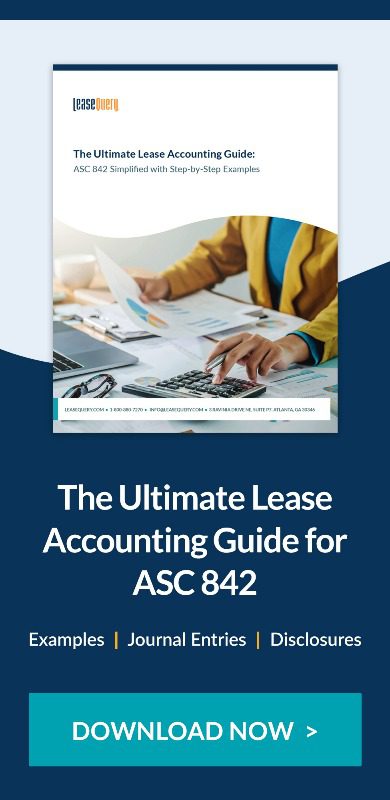ASC 840 summary
ASC 840, Leases, is the former lease accounting standard for public and private companies following US GAAP. Under ASC 840, leases were classified as either capital or operating, significantly impacting the contract’s effect on the company’s financial statements. Capital lease classification resulted in a liability recorded on a company’s balance sheet, whereas operating leases did not impact the balance sheet. Operating leases may have been disclosed in the footnotes of the financial statements, sometimes within the commitments and contingencies disclosure.
Balance sheet recognition for operating leases
Based on feedback from the investing community, the SEC agreed the accounting presentation of operating leases did not provide enough visibility regarding the obligation for future lease payments. Under ASC 840, operating leases did not impact the balance sheet. As a result, FASB announced the initiative to update the lease accounting standard.
As noted in the FASB’s exposure draft, “It is important that lease accounting should provide users of financial statements with a complete and understandable picture of an entity’s leasing activities.” Under ASC 842, the new lease accounting standard, the future lease payments for operating leases are required to be recognized on the balance sheet.
ASC 840 to ASC 842 transition date
Public calendar-year companies had until January 1, 2019, to adopt ASC 842 as the new standard was effective for reporting periods beginning after December 15, 2018. While calendar-year private companies were initially given an extra year to adopt, the FASB granted an additional extension after many companies felt unprepared for the transition.
Then, due to the global impact of the COVID-19 pandemic, another extension was granted. After the second extension, calendar-year private companies were required to adopt ASC 842 for fiscal years beginning after December 15, 2021, and interim periods within fiscal years beginning after December 15, 2022.
ASC 840 vs ASC 842
Below are a few of the key differences between ASC 840 and the current FASB lease accounting standard, ASC 842, with a focus on the lessee accounting treatment. Some significant differences between the two lease accounting standards exist.
1. Determination of lease classification
Under ASC 840, lease classification (i.e., determining if a lease is a capital or operating lease) was decided when the lease was executed (i.e. lease inception). Under ASC 842, the lease classification (finance or operating) is determined at lease commencement.
2. Lease classification criteria
Under ASC 840, four tests determined capital lease vs. operating lease classification:
- Ownership transfer
- Bargain purchase option
- Lease term greater than or equal to 75% of the useful life of the asset
- Present value of minimum lease payments greater than or equal to 90% of the fair value of the leased property
Under ASC 842, “capital” leases are called “finance” leases” and these four criteria generally remain, although the bright-lines related to the 75% and 90% were removed. ASC 842-10-55-2 provides guidance that the 75% threshold represents a “major part” of the remaining economic life of the underlying asset and the 90% threshold represents “substantially all” of the fair value of the underlying asset.
A fifth test was also added focusing on highly specialized assets. Under this test, if the leased asset is specialized or modified at the end of the lease term, to have no alternative use to the lessor, then the lease is classified as a finance lease.
The fifth test is new for lease accounting. While this could result in a lease being classified as a finance lease under ASC 842 when it would have been an operating lease under ASC 840, we have tended to see a contract triggering the specialized use test, also triggers one of the other criteria, due to the lessor wanting to ensure the arrangement is profitable.
As each test is performed, it’s important to determine if the lease is a strong-form or weak-form finance lease. The accounting treatment for what are now considered finance leases has not changed much, aside from being amortized over the asset’s useful life (strong-form) or the shorter of the useful life or the lease term (weak-form).
For a full example of finance lease accounting, view our article, “Capital Lease Accounting and Finance Lease Accounting under ASC 842 Explained with a Full Example”
3. Lease payments, executory costs, and tenant improvement allowances
Under ASC 840, minimum lease payments are defined as payments a lessee is obligated to make in connection with the leased asset, excluding contingent rentals and executory costs. Minimum lease payments were the payments required to be capitalized for a capital lease under ASC 840.
Under ASC 842, fixed payments and “in-substance” fixed payments are identified as payments that will determine the amount of the liability and corresponding asset recorded on the balance sheet. These fixed payments likely include base rent as these payments are known and fixed throughout the life of the lease. “In-substance” fixed payments are payments that may appear to be variable, but are in effect, unavoidable.
Executory costs (i.e. insurance, taxes, maintenance) is a term defined under ASC 840, and the treatment of these costs has changed between the two standards. Under ASC 840, these costs were excluded from all lease calculations. Instead of executory costs, ASC 842 introduces the concept of lease and nonlease elements.
Lessees are now required to allocate contract consideration between lease and nonlease components. ASC 842 requires entities to evaluate whether costs represent payment for the right to use the underlying asset (i.e. a lease component) or whether the payment is for a good or service transferred to the lessee that is separate from the right to use the underlying asset (i.e. a nonlease component).
Unless the company takes advantage of a practical expedient that allows the lessee to combine lease and nonlease components, the payments related to the identified lease components are the amounts included in the balance sheet capitalization. Based on this definition, insurance and taxes will be allocated amongst the lease and nonlease elements, and maintenance is considered a nonlease element and not included within the lease payments. Therefore, under ASC 842, taxes or insurance could be included in the lease payments, whereas they would be excluded under ASC 840.
A tenant improvement allowance (TIA) is a lease incentive defined as money paid by a landlord to the tenant to reimburse the tenant for construction modifications of a property. Lease incentives, including a TIA, are accounted for differently under ASC 840 versus ASC 842. ASC 840-20-25-6 states lease incentives shall be recognized as reductions to rental expense by the lessee (reductions to rental revenue by the lessor) on a straight-line basis over the term of the lease.
Under ASC 842, the accounting treatment of a TIA is based on whether the lessor paid the allowance at or before lease commencement, or if it is considered payable at lease commencement. If the TIA is paid at or before lease commencement it will decrease the opening ROU asset. However, if the TIA is payable at lease commencement it will decrease fixed lease payments. If the allowances are spread in installments, it will decrease fixed lease payments for the respective periods of the installment for present value calculation in ASC 842. Walk through a full example of tenant improvement allowances under ASC 842.
4. Fair value adjustment
Under ASC 840, a lessee cannot record a capital lease asset at an amount greater than the fair value of the asset. In such scenarios, companies are required to increase the discount rate to a rate that will reduce the asset, and the lease liability, to an amount equal to the fair value of the underlying asset.
Under ASC 842, the asset should be recorded at the amount calculated using the appropriate discount rate (the rate implicit in the lease if known, the incremental borrowing rate, or the risk-free rate for private entities), even if the ensuing amount exceeds the fair value. Subsequently, the asset will then be tested for impairment and written down if necessary.
5. Difference in the discount rate used
ASC 840 requires entities to use the rate implicit in the lease (if known) or the entity’s incremental borrowing rate. Under ASC 842, entities should first attempt to recognize the lease using the implicit rate. Lessors should know this rate and therefore, are required to use it. However, for lessees, this rate is often not readily available or easily determinable, so lessees are permitted to use the incremental borrowing rate, or in the case of private entities, the risk-free rate.
Therefore, under both ASC 840 and ASC 842, a lessee is often using the incremental borrowing rate to account for the lease. However, the “incremental borrowing rate” is defined differently in each standard. Under ASC 840, the incremental borrowing rate is “the rate that, at lease inception, the lessee would have incurred to borrow over a similar term the funds necessary to purchase the leased asset.” Whereas, under ASC 842, it is “the rate of interest that a lessee would have to pay to borrow on a collateralized basis over a similar term, an amount equal to the lease payments in a similar economic environment.”
Under ASC 842, the incremental borrowing rate relates to a rate an entity would be charged to borrow, assuming collateral, over a similar term.In contrast, under ASC 840, the incremental borrowing rate used was very often a borrowing rate obtained from the Treasury Department.
An additional option under ASC 842 is the risk-free rate, only available to private companies as a practical expedient. As such, under ASC 842, an entity will have to put more effort into identifying the appropriate discount rate to record for each lease.
6. Deferred and prepaid rent
Under ASC 840, total rent expense is required to be recognized on a straight-line basis over the lease term even if rent payments vary. Deferred rent is a liability (or less often an asset) resulting from the difference between actual cash paid and the straight-line expense recorded on the lessee’s financial statements for an operating lease.
Under ASC 842, deferred and prepaid rent accounts will be eliminated from the balance sheet. The new lease accounting guidance explicitly states that following the commencement of an operating lease, the ROU asset will be adjusted for several items, including any prepaid or accrued lease payments. Deferred rent, depending on whether it is a cumulative positive or negative amount, is either accrued rent or prepaid rent.
7. Residual value guarantees
The accounting treatment for a residual value guarantee changes slightly under ASC 842. This type of guarantee is primarily found in equipment or vehicle contracts.
When calculating the capitalized lease liability under ASC 840, the entire amount of any residual value guarantee was included in the minimum lease payments. Under ASC 842, however, only the amounts expected to be owed at the end of the lease term should be included as lease payments when determining the lease liability.
8. Lessor leases
Overall, the new ASC 842 accounting standard affects lessees much more than lessors. The lessor-seller will continue to recognize lease income for their leases, and balance sheet recognition requirements remain the same. However, ASC 842 requires lessors to adopt new terminology to classify the type of lessor lease. The three types of lessor leases under the new guidance are direct financing, sales type, or operating lease. Lessors-sellers have the option to elect a package of practical expedients when transitioning from ASC 840 to ASC 842 in which the lessor is not required to reassess lease classification.
Summary
This blog provides an overview of the key differences between lease accounting under ASC 840 and accounting for leases under ASC 842. Check out our Ultimate Lease Accounting Guide to learn more about the new FASB standard.



